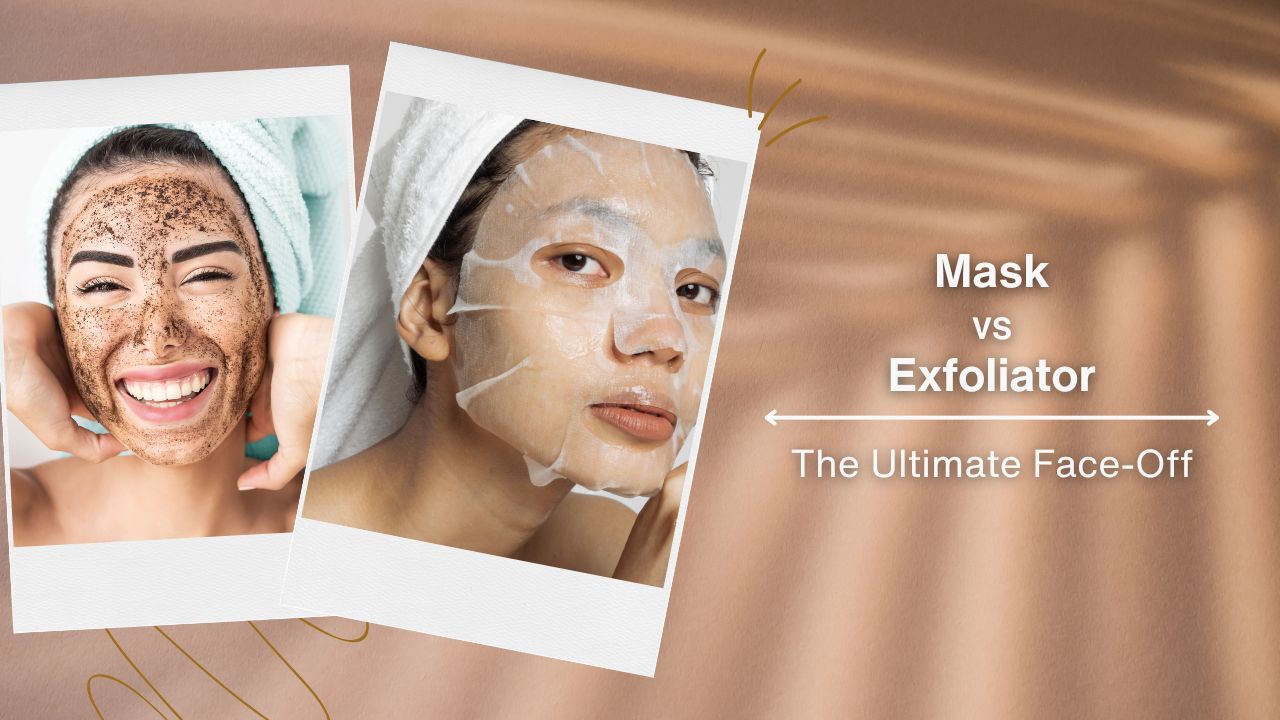Mask VS Exfoliator — The Ultimate Face-Off

Mask or exfoliate? Exfoliate or mask? Have you ever debated this while planning your ideal pamper session? Oh well, you are not alone. It’s an age-old musing with no end in sight. Your esthetician does wonders with exfoliation AND applying a mask on your skin. But when at home, which one to do? Which one is better? This is the blog for you to figure that out. So, then, without much ado — let us delve straight into the ultimate face-off of mask vs. exfoliator. And while we are at it, let us invite a 5000-year-old special guest to referee the match!
What is a Mask?
To define it in industrial terms, a mask is a skincare product applied to the face to deliver targeted benefits. It may be a paste or a slurry, sometimes even a sheet soaked in rich serums. The end goal is hydration, detoxification, or rejuvenation. Masks come in various forms. Some are clay masks for sucking out dirt, others are sheet masks to feed ample hydration. Gel masks and cream masks usually serve cooling purposes. But all the masks, irrespective of their specific focus, are intensely relaxing. Pampering.
Benefits of Masks:
- Deep cleansing: To remove impurities and excess oil from pores.
- Hydration: To replenish moisture for dry or dehydrated skin.
- Brightening: To even out skin tone and enhance radiance.
- Anti-aging: To tighten the skin, and reduce the appearance of fine lines and wrinkles.
Types of Masks:
- Clay Masks (e.g., Bentonite, Kaolin)
- Sheet Masks
- Gel Masks
- Cream Masks
What is an Exfoliator?
Taking a leaf from the above section, an exfoliator is a skincare product designed to slough off dead skin cells. It simply works like sandpaper, to put it crudely. The result is smoother, brighter skin that pops out of underneath all that clutter. Exfoliation is also known to promote cell turnover, unclog pores, and enhance the skin's natural texture. Exfoliators come in two main types: physical exfoliators, which contain abrasive particles to manually scrub away dead skin cells, and chemical exfoliators, which use acids like alpha hydroxy acids (AHAs) or beta hydroxy acids (BHAs) to dissolve dead skin cells.
Benefits of Exfoliators:
- Smoother Texture: To improve skin's texture and tone.
- Unclog Pores: To prevent breakouts and minimize the appearance of pores.
- Enhance Absorption: To allow skincare products to penetrate more effectively.
- Brighten Skin: To reveal a more radiant complexion.
Types of Exfoliators:
- Physical Exfoliators (e.g., scrubs, brushes, pumice stones, beads in exfoliants)
- Chemical Exfoliators (e.g., AHAs, BHAs, enzymes)
Mask vs Exfoliator: Differentiation
- While both contribute to healthy, radiant skin, they serve different purposes in a skincare routine.
- Masks provide targeted treatment for specific skin concerns. Exfoliators on the other hand serve a broader purpose of removing dead skin cells.
- Masks work by delivering active ingredients into the skin. They may also work by absorbing deep-seated impurities from the pores. Exfoliators are more of foot soldiers. They physically or chemically remove all the useless, dead, and damaged skin cells that may weigh your skin down.
- Another major difference is the frequency of use. See, you may use your mask once, even twice a fortnight. But exfoliators need more frequency, especially if you have very dry skin. Depending on your skin type, the exfoliator you choose, and your skin’s response to it, you may exfoliate almost 2 to 3 times a week.
Ayurveda on Masks and Exfoliators
And here’s our 5000-year-old guest, bringing age-old ideas about masks and exfoliants:
In Ayurveda, skincare has often been connected to nature. Even the textual references have incorporated the five elements — fire, earth, water, sky, and air into explaining the Prakriti (constitution) and doshas (imbalance).
Ayurvedic texts refer to masks as Lepa and exfoliators as Garshana. These have been called essential components of skincare rituals. A lepa is essentially made from mud (ubtan, multani mitti, etc), powders of flowers and fruit peels, and kitchen ingredients like curd, honey, or pastes of herbs with oils. In contrast, garshana are systematic exfoliants made from coarse flours like chickpea, red lentil, wheat, etc with a natural emollient that can be used to scrub the skin. Spices like turmeric, cinnamon, nutmeg, etc often serve antibacterial, and antimicrobial functions for different skin doshas like vata, kapha, and pita.
Verdict as per Ayurveda
Harmony in skincare is achieved when everything is in balance. For this, one must nourish the skin with lepa from time to time, more often if you suffer from skin problems like acne. In order to slough off the dead and grow the new cells, you also need regular garshana. That is how you continue to glow.
Conclusion
There is no clear winner. Because masks and exfoliators are both indispensable tools in the quest for healthy, glowing skin. So, if you want to explore and unleash the full potential of your skin — then nourish it well, exfoliate it well, and enjoy both processes like the queen you are. To start scouting your perfect pair of Ayurveda-inspired masks and exfoliators, check out the Savarnas Mantra online store.
#Skincare #FaceMask #Exfoliation #BeautyRoutine #AyurvedaSkincare #HealthySkin #RadiantComplexion